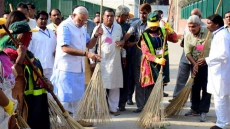The most crucial inclusion in the India-US Joint statement issued on Sep 30 is the strategic partnership on energy and climate change. The actions agreed will have far reaching impacts on India's poor, neo-middle class and youth. They will also enhance the image of an India as a steward in international negotiations on environment.
At WTO, India resisted the American pressure to amend Trade Facilitation Agreement (TFA), only to protect the hundreds of millions of poor and hungry Indians. Now, India, through actions planned in partnership with the US, has unique opportunity to act on climate change and secure future of poor workers and farmers.
Till now India, over the last 17 years has been resisting at international meetings to avail an important the opportunity to make its refrigeration and air conditioning industry move away from a refrigerant - hydrochloroflurocarbons (HFCs). Nearly 100 countries including the US and Japan and those in Europe have given their consent but India continues to block this agreement. Many countries are even advancing to implement it. In Europe, for example, a new law will phase down HFCs by 80 percent by 2030. In the US, President Barack Obama is also using his regulatory authority to shift away from HFCs - and is promising to do even more.
India's blockade, unlike in case of WTO, is not for the interest of the poor. Far from it. Indian negotiators question the availability of alternatives to HFCs. They debate if the Montreal Protocol is he right forum for the action against HFCs. In reality, this stand completely ignores the opportunity for India to avail larger national benefits for the poor and neo-middle class.
The refrigeration and air-conditioning industry has made enormous contribution to protect the stratospheric ozone layer by effectively implementing the Montreal Protocol. By 2010, as per the Montreal Protocol, it had eliminated production and consumption of CFCs. Now it, like other developing countries, is phasing out the last remaining ozone depleting chemical - hydrochlorofluorocarbons (HCFCs). However, in most cases HFCs were introduced as alternative to CFCs and now HCFCs.
The annual global growth of HFCs, which are mainly used in room and car air-conditioners, is eight percent but in emerging economies like China and India it is more than 10 to 15 percent. It is likely to be 20 percent soon due to increasing demand on air-conditioners from the rising neo-middle class.
As the plans declared by Prime Minister Narendra Modi for 100 smart cities goes on stream, as the cold storage requirements increase to feed in those cities, as the number of refrigerated facilities increase to prevent the waste of perishables to give better income to farmers for their produce, the demand for HFCs would further rise. If left unchecked, by 2050, annual HFC emissions could be equivalent to 12 percent of annual CO2 emissions under a business-as-usual scenario and up to 75 percent of annual CO2 emissions under the IPCC's strongest mitigation scenario.
Scientific studies say global fast action on HFCs phase down will avoid up to 200 billion tonnes of CO2 emissions by 2050 and up to 0.5 degrees Celsius of warming by 2100. Avoiding this warming is essential for staying within the long-term international goal of stabilizing global temperature rise at or below 2 degrees Celsius over pre-industrial temperatures by the end of the century.
Are the alternatives to HFCs available? Godrej in India has already commercialized room air-conditioners without HFCs. It uses hydrocarbons (HC), which are easily available in India and much cheaper. The energy efficiency of such air conditioner is also at least 10 percent higher. I myself use HC-based room ACs at my home. I have also test-driven a Tata Motors car that uses a non-HFC alternative. The alternative for car air conditioners is presently costly. However, as we have witnessed under the Montreal Protocol, when the consumption grows the price comes down.
When India phased out CFCs, the energy efficiency of the appliances using CFC-alternatives went up to the extent of nearly 30 percent to 60 percen. If we enhance the energy efficiency of non-HFC (or very-low global warming HFCs) room ACs, and even make super efficient AC in India-as per Modi's 'Make in India' campaign and as intended in the US-India partnership statement, the benefits to consumer at micro-level and to India at macro-level would be enormous.
India's air conditioning sector uses up to half of the available electricity during the sub-continent's hottest months. The peak demands during the hottest days burden India's timeworn and tattered power grid. The power outage in India in July 2012 was the largest in the history. Nearly half of India's population suffered during this black out-mainly blamed for the use of air conditioning systems.
A recent study by the Lawrence Berkeley National Laboratory of USA calculates that super-efficient air conditioning in India could avoid the need to build up to 120 medium-sized power plants by 2030. This would save $60 billion just in construction costs. It also would save Indian consumers and businesses money and take pressure off the electric grid, reduce emission of carbon dioxide and reduce air pollution.
Implementing HFC phase-down under the Montreal Protocol, India during negotiations can insist on applying the same rules as accepted under the Montreal Protocol - getting a grace period by requesting industrialized countries to carry out HFC phase-down first, ensuring that alternatives are available and affordable, getting full incremental cost of transition away from HFCs and getting the energy efficient and even super-efficient technology. This opportunity is being withered away by India for last few years by splitting hair on legal issues without understanding the larger interest of India's poor and aspirations of the emerging neo-middle class.
Air pollution can be reduced by enhancing the energy efficiency and by avoiding new power plants based on fossil fuel. Millions of poor lives will be saved. India's import of fossil fuel would also stand reduced.
The Clean India campaign, pronounced by Modi, started Oct 2 on the occasion of Mahatma Gandhi's birth anniversary. It should not be restricted only to sweeping the roads, brushing the walls and dusting the files. It should move beyond - and also clean the skies from air pollution by making ACs super-efficient and HFC free.





